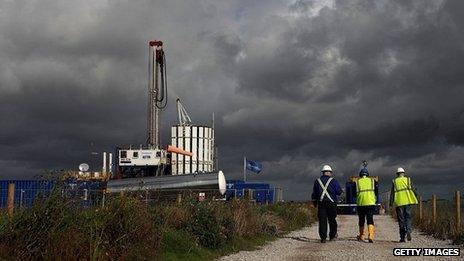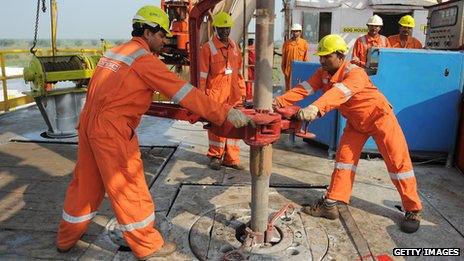Shale industry faces global reality check
- Published

The shale industry faces a number of obstacles in the UK and globally
As US energy costs tumble on the back of shale oil and gas, the rest of the world is gripped with envy.
Just four years ago, natural gas prices in Europe were roughly comparable with those in the US; now they are three times higher. In Japan, they are five times higher.
Understandably, countries around the world want a piece of the action.
Governments from the UK and Poland to China and Argentina are dreaming of cheap power and, just as importantly for some, energy security. Shale, many have decided, is the answer.
But can the shale gas revolution in the US really be replicated around the world?
'Failed experiment'

Poland was seen as the poster boy for European shale gas but, according to Stuart Elliott, managing editor at the industry information provider Platts, "the Polish experiment has been a failure to date".
Enticed by seemingly abundant reserves and a government keen to kick-start production, US energy majors moved in, hoping to replicate their domestic success on foreign shores.
Thirty to 40 wells were planned for 2013. To date, there is just one well producing enough gas to be economically viable.
Exxon Mobil, Talisman and Marathon have all pulled out, while Chevron, Conoco Phillips and San Leon are persevering.
Much of the blame has been laid at the door of the government, which got "greedy and stupid", according to Prof Paul Stevens, senior research fellow at the Chatham House think tank.
A punitive tax regime and an insistence that foreign companies work with local partners did much to dampen enthusiasm, although the government has since made its regulatory regime more attractive to overseas investors.
But more significant for the wider shale industry in Europe, says Prof Stevens, were comments made by Exxon's chief executive. The technology that had proved so successful in the US did not work on Polish geology, Rex Tillerson said.
'High suspicions'
The UK government is another that has high hopes for shale, but only a handful of test wells have been drilled in the past four years. In the US, more than 100 wells were needed before the industry was satisfied that shale gas was viable.
This inactivity is largely due to public opposition to fracking - the process of drilling for shale gas - and an 18-month moratorium on drilling following concerns about earth tremors.
The BBC's David Shukman explains how fracking works
"Suspicions are high so the regulatory regime needs to be very robust," says John Williams, senior principal at Poyry Management Consulting. "Everything needs to be gold-plated - any slip-ups and it's game over. This is why we haven't really moved forward."
And opposition will not go away.
Concerns about water contamination, earthquakes and disruption to rural communities have captured the public imagination, but experts suggest we may be worrying about the wrong things.
"The argument that fracking damages the water supply doesn't stack up, and any disruption would be fairly short-lived," says Prof Stevens.
Concerns about earthquakes were always something of a red herring.
"The legitimate concerns," says Prof Stevens, "are 'What do we do with the waste water - there are nasty heavy metals and radioactivity [deep under ground]?' There is also the question of fugitive methane - we simply don't know how much leakage there is."
He also points out that while shale gas may be less polluting than coal and oil, it is still a fossil fuel. "If we have any hope of hitting our two-degree [climate change] target, burning gas is not the way.
"Diverting investment from renewables is also a genuine concern".

Anti-fracking protests have taken place in several countries around the world
And opposition is not confined to the UK. Protests have taken place around the world, with activists from more than 20 countries signing up to Global Frackdown day last year. France has banned fracking, while moratoriums have been put in place in Germany, Romania and Bulgaria.
Basic research
But public opposition, partly because Europe is more densely populated than the US, where people are far more familiar with oil and gas operations, is just one of many factors holding back shale development.
For a start, environmental regulation is far stronger in Europe.
There has also been relatively little government investment in research and development outside America. The US government ploughed millions of dollars into basic scientific research in the early 1980s, while the European Commission wants the industry itself to make these investments in R&D. This is by no means a given.
After all, the US shale industry did not appear overnight, but has developed over the past 25 years.
Property rights are also key, says Prof Stevens. In the US, homeowners usually own the minerals under their land, so they can agree a price and hand over the rights to an energy company. In Europe, the state tends to own the minerals, and no-one is going to let an energy company rip up their land without a fight.
Add to this questions about the suitability of the geology in many countries and the lack of infrastructure and pipelines, and it is clear that the barriers to a shale revolution outside the US are considerable and numerous.
There are also questions about the ultimate impact of shale on energy prices in Europe, which operates an integrated market across the continent.
Forecasts by Poyry suggest wholesale gas prices might be between 6% and 14% lower over the period 2020-50, while electricity prices might be between 3% and 8% cheaper. The impact on household spending would be lower, as the wholesale price is just one component of energy bills.
These figures suggest the impact of shale on energy prices in Europe would be far less significant than in the US.
Ambitious targets
One country where the prospects for shale do look brighter is China.
"Gas demand is set to rocket and they are looking to spend billions on shale," says Mr Elliott. The government plans to produce about one-third of the current US shale gas capacity by 2020.

India drilled its first shale gas test well last November
Experts view this target as ambitious to say the least, but the country has the right geology, a cheap labour market, far fewer regulatory obstacles and, so far, relatively little public opposition.
The main issue is water. Much of China's shale reserves are located in the north west of the country, which is extremely arid. This is a "major sticking point", says Mr Elliott.
And despite the government's grand plans, so far all China's efforts to exploit its abundant shale resources have come to nothing. In fact, while there are thousands of shale wells in the US, there are only a handful producing commercial quantities of gas in the whole of the rest of the world.
Mr Williams thinks it will be eight to 10 years before China is producing a significant amount of shale energy, let alone enough to affect the overall price of gas. And this in a country where there are relatively few barriers to entry.
For the rest of the world, then, any significant shale production within this timescale seems wholly unrealistic. "You can forget about the next five to 10 years," says Prof Stevens. "Fifteen to 20 is a possibility".
Those governments looking to shale as a quick fix for high energy prices and security of supply may, then, have unrealistic expectations. Shale may not be the saviour that many hope it to be.